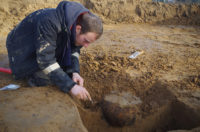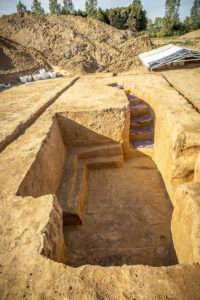 Archaeologists have discovered the remains of a Roman-era iron smelting operation in Ninove, East Flanders, Belgium. These are the first traces of Roman iron production ever found in the region.
Archaeologists have discovered the remains of a Roman-era iron smelting operation in Ninove, East Flanders, Belgium. These are the first traces of Roman iron production ever found in the region.
The Doorn Nord site is being archaeologically surveyed in advance of construction of a business park. Since the investigation began 18 months ago, the team has unearthed two funerary monuments from the late Neolithic (2500-2000 B.C.) and a smattering of Bronze Age (2000-1000 B.C.) remains, but the densest concentration of ancient material dates to the late 1st and 2nd century A.D. when a Roman settlement grew at the intersection of two roads.
The settlement contains houses, streets and graves and appears to have specialized in metal craft, specifically the smelting of iron ore into iron. Archaeologists are hoping to discover how much ore was produced and what it was used to make.
 The greatest number of remains are of more recent extraction: military encampments from the late 17th to the mid-18th centuries. Flanders was a hot potato that changed hands repeatedly (between France and Spain, mainly) during the Nine Years’ War and the War of the Spanish Succession. The camp features small shelters cut into the clay of the ground itself. They had staircases, benches, hearths and fireplaces and could keep six men seated and warm around a fire. No roofs have been found yet and it’s not clear how the smoke was channeled out of the small space.
The greatest number of remains are of more recent extraction: military encampments from the late 17th to the mid-18th centuries. Flanders was a hot potato that changed hands repeatedly (between France and Spain, mainly) during the Nine Years’ War and the War of the Spanish Succession. The camp features small shelters cut into the clay of the ground itself. They had staircases, benches, hearths and fireplaces and could keep six men seated and warm around a fire. No roofs have been found yet and it’s not clear how the smoke was channeled out of the small space.
 In June of last year, the city recreated the 17th century encampment so people could hear what it was like to live there from a “soldier’s wife” while sitting in the reconstructed bunkers. More than 4,000 visitors enjoyed the recreations, period crafts, combat demonstrations and archaeology workshops.
In June of last year, the city recreated the 17th century encampment so people could hear what it was like to live there from a “soldier’s wife” while sitting in the reconstructed bunkers. More than 4,000 visitors enjoyed the recreations, period crafts, combat demonstrations and archaeology workshops.